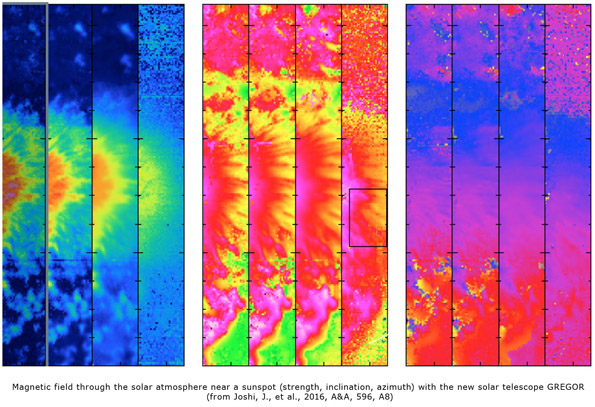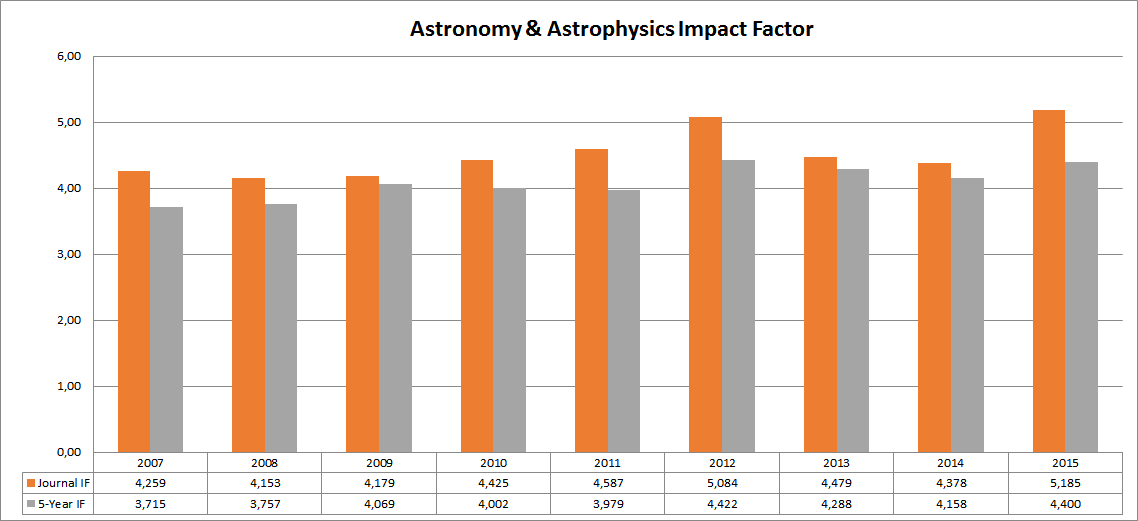News archive
- Details
- Published on 29 November 2016

Astronomy & Astrophysics, published by EDP Sciences, has released a series of papers on the first science data from the GREGOR telescope (the largest of its kind in Europe.)
GREGOR is a solar telescope designed to observe the solar photosphere and chromosphere in the visible and the near-infrared wavelengths. Its main mirror (1.5m diameter) allows for solar images of unprecedented quality and resolution. To read Press Release click here.
To read the special issue, please click here.
- Details
- Published on 24 November 2016

Astronomy & Astrophysics, published by EDP Sciences, has published a special issue gathering papers describing the GAIA data release and their validation.
Gaia is an ESA mission to survey one billion stars in our Galaxy and local galactic neighbourhood in order to build the most precise 3D map of the Milky Way and answer questions about its structure, origin and evolution.
To read the special issue, please click here.
- Details
- Published on 26 September 2016
Following the successful launch of Writing Studio for the authors of A&A journal, there have been further developments that now allow researchers to submit their paper to A&A via Writing Studio.
Writing Studio is a unique collaborative writing LaTex solution designed to simplify the process of writing an A&A article collaboratively on a single version of a paper. Now, A&A authors are able to use Writing Studio from the beginning of an article through to its submission.
For more information about Writing Studio please visit - http://writingstudio.aws.edpsciences.org/login.
- Details
- Published on 12 August 2016
After having published Research Notes for many years, A&A has decided to discontinue this category of papers.
- Details
- Published on 17 June 2016

The latest Journal Citation Reports® recently announced by Thomson Reuters have revealed that Astronomy & Astrophysics’ Impact Factor has risen to 5.185*.
This confirms A&A’s position as one of the leading journals in the field, publishing the very best papers on all aspects of astronomy and astrophysics.
Click here to read the journal or to submit a paper.
*2016 Release of Journal Citation Reports. Source: 2015 Web of Science Data"

- Details
- Published on 03 June 2016
Astronomy & Astrophysics is pleased to announce publication of the complete version of the XXL Survey special feature. A first series of papers and a press release were issued last December, and we are now publishing the final series of twelve papers. XXL is a large survey of the X-ray sky with the XMM-Newton ESA observatory. Its goal is to detect a few hundreds of clusters at a look-back time when the age of the Universe was about half its present value. The ensemble of results published in this A&A special feature shed light on the evolutionary properties and spatial distribution of the massive structures of the universe and, subsequently, on various cosmological properties.
- Details
- Published on 25 March 2016

Astronomy and Astrophysics (A&A) Journal and EDP Sciences are pleased to announce the launch of Writing Studio, a unique collaborative writing LaTex solution designed to simplify the process of writing an article collaboratively on a single version of a paper. Reinforcing an open-source strategy, EDP Sciences has chosen the Open Source ShareLateX to develop this new service.
Writing Studio provides:
- A collaborative LaTeX solution: Multiple co-authors can jointly work on a single version of the paper with up-to-date A&A macros already included.
- Direct communication between co-authors: Co-authors can ask each other questions and can chat for real-time interactions.
- Dropbox integration: Articles can be edited offline and automatically synchronized with the Dropbox online copy.
- Ease of submission (coming soon): Article will be uploaded to the A&A submission system with a single click, with key fields pre-filled ready for checking.
- Easier links to astronomical objects: Authors get auto-completion for stellar objects and additional information using tools developed with the CDS.
- ORCID integration: Authors login to Writing Studio and are recognized by their ORCID iD.
The next step is to link Writing Studio with all the EDP Sciences journals and their submission systems and integrate this tool in a comprehensive LaTeX dedicated workflow, from the writing of an article through to its online publication.
Login to the Writing Studio using your ORCID iD.
Read Press Release for more information
- Details
- Published on 28 January 2016

in Kiev in 1974.
Copyright: Gérard Epstein, 1974
Jean-Louis Steinberg passed away in Paris on 21 January 2016, at the age of 93. He was one of the founders of radioastronomy in France and a pioneer of astronomy from space at the Paris Observatory. Last, but not least, he also played a leading role in the creation of the journal Astronomy & Astrophysics.
Jean-Louis was born on 7 June 1922, in Paris, and as a young man he began his studies to be a scientist and became a Doctor of Engineering in 1943. However, in June 1944, he was arrested and deported with his parents and one of his two brothers. He was the only survivor of the four when the US Army liberated the camp. Conscious that he was one of the last direct witnesses of the Holocaust, after his retirement he devoted much of his time to keeping the memory of the deportees alive. Right up until the last days of his life, he was providing testimonials of the horror of the concentration camps to schools and conferences.
After the WWII, he completed his studies and entered the physics laboratory of the École Normale Supérieure. This was just the start of a very successful scientific career. He also liked writing and was interested in scientific publications. In 1962, he was offered the job of Editor-in-Chief of the French journal, Annales d’Astrophysique, one of three professional journals in astronomy that were published in France at the time. He ran the journal with his wife Madeleine, who was fluent in English and Russian. In 1968, they decided to evaluate the usefulness of the work that had been carried out over the previous six years. However, when they looked up citations of the papers published in their journal in the Science citation index they were horrified to find that their journal had not even been mentioned. They concluded that English-speaking scientists were probably not reading it since it was clear, when they looked at the citations in American and English journals, that it was mostly being quoted by its own authors.
Jean-Louis shared his dismay with Stuart Pottasch, the Editor-in-Chief of the Bulletin of the Astronomical Institutes of the Netherlands, who was having a similar experience, and they began talking about merging their publications in a new international journal. They found initial support from Jan Hendrik Oort, director of the Leiden Observatory, and from Anders Reiz, director of the Copenhagen Observatory, with whom they discussed the possibility of also merging the Scandinavian journals into a new publication. Together with Jean-François Denisse, director of the Paris Observatory, Jean-Louis then called a meeting of French astronomers during the turmoil of the 1968 events. He managed to convince them to merge the three French astronomy journals into one new publication.
Meanwhile, the idea of a new international astronomical journal had also been gaining ground in Germany and Belgium, as well as in all Scandinavian countries. At a subsequent meeting of key actors, held in Leiden on March 27, 1968, the general principles for the operation of the new journal, with the proposed name, “Astronomy & Astrophysics: A European Journal”, were also discussed. ESO was then asked to provide a legal framework for the new journal and its Council responded favourably in July 1968. As a result, Astronomy & Astrophysics saw the light of day and the first issue was published in January 1969. Naturally, Jean-Louis Steinberg and Stuart Pottasch were the two first Editors-in-Chief. Jean-Louis remained in this position for five years, ensuring the huge success of the new journal.
Jean-Louis and Madeleine ran the Meudon A&A editorial office during those five years with the help of a secretary and a part-time draughtswoman. There were only four issues of the journal in 1969, but it soon became a monthly publication and one of the four major generalist astronomical journals in the world. Initially, papers were submitted in English, French or German, but it soon became clear that, for a given author, the papers in English were cited twice as often as those in other languages. As a consequence, the vast majority of papers were soon written in English and corrected, when needed, by Madeleine.
Clearly, Jean-Louis was a pioneer in European scientific publishing: astronomers were the first to succeed in merging their journals into a single publication, and the refereeing system he set up was run very smoothly. Since then, his successors have attempted to maintain the high standards he defined as best as they could.
Those of us who were privileged to know Jean-Louis Steinberg as an Editor-in-Chief will remember him as always being accessible and attentive to authors. He was a man of exceptional moral integrity, a hard worker, a visionary and a bright and charismatic scientist and editor.
James Lequeux, Claude Bertout, Nabila Aghanim, Thierry Forveille
N.B. Jean-Louis Steinberg published a detailed account of his life and activities in an article entitled “The scientific career of a team leader”, Planetary and Space Science 49 (2001) 511-522.
- Details
- Published on 21 December 2015
EDP Sciences and Astronomy & Astrophysics are glad to announce the "4th Scientific Writing for Young Astronomers", which will be held in Puerto Varas, Chile, from 19th to 22th April, 2016.
The direct purpose of organizing an “Astronomy and Astrophysics School” is to teach beginning PhD Students how to express their scientific results through correct and efficient science writing. In other words, how to write scientific papers for different forums (journals, proceedings, thesis manuscripts, etc.)
For further information, we invite you to visit our website and to like our Facebook page "Scientific Writing for Young Astronomers".
Patricio Rojo
Director of the school
- Details
- Published on 06 November 2015
EDP Sciences has recently added the Altmetric data for Astronomy & Astrophysics.
Altmetric data gives users a more complete picture of how people are engaging with scholarly literature by tracking a variety of sources, including news, social media, bookmarking and peer-review forums, to provide data on the online activity surrounding each research article.
Readers can click on the Altmetric badge to view the original mention and explore the news stories, tweets, blogs and more for themselves.
This data is important to both authors and readers, helping them understand the wider dissemination of research, and allows them to engage in online conversations they may not have been aware of.

See http://www.altmetric.com for more information.


